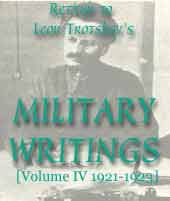
In the last two volumes of the Military Writings, Trotsky draws out the lessons of the civil war years and the construction of the Red Army.
The years 1921-1923 were punctuated by the Kronstadt rising, by bandit incursions and by the continuing war threat from the west. They were nevertheless years in which the most immediate danger to the Soviet frontiers had been overcome and the interventionist forces pushed back.
The problems of Soviet Russia’s international situation and of its internal economic development now occupied the attention of the Bolshevik leadership. Trotsky recognised that with international capital unable to crush the October Revolution as it had wished, a more prolonged, bitter period of class warfare was on the agenda throughout Europe. This meant that while the Red Army moved over to a ‘peace footing’, its leadership faced the task of training and preparing it against renewed dangers.
Within Russia itself, the turn was made in 1921 to the New Economic Policy – described by Trotsky as neither a victory nor a defeat, but a strategic retreat. Openings were made for small and medium enterprise and to concessionaires in order to get the war-shattered economy moving.
On the military front, the emphasis was on education, study and training. Here Trotsky squarely confronted the problems of Russian backwardness and the difficulties of training the peasant masses who formed a large proportion of the Red soldiers. As he says (p.73) ‘the working-man hero will much sooner and more readily die on horseback for the Soviet Republic than he will take care to see that his horse is groomed as and when he should be.’ It was for this reason that Trotsky insisted on the highest standards of training and fought for organised, systematic construction in opposition to the old ways of managing ‘somehow’. He calls repeatedly for precision, accuracy and ‘attention to trifles’. His speeches to students at the military schools and on command courses repeatedly attack slipshod methods and fight to instil pride in the record and traditions of the Red Army units.
To carry through this struggle required a high level of political work by the Communist Party members within the Red Army. At the same time there re-emerged the question of non-Party military specialists which had been raised at the outset of the building of the Red Army. When some elements in the Party proposed restricting access to the higher military academies to Party members only, Trotsky vigorously opposed them. Rejecting all narrow and doctrinaire conceptions of ‘Marxism’, he reiterated the need to utilise all those military specialists who were prepared to put themselves at the service of the workers’ and peasants’ state. Marxism is not a set of formulae for all spheres of human activity, and the socialist revolution had to learn to make use of all knowledge and skills developed under the previous order, for its own ends. In the final volume these lessons are further elaborated in the discussion on Marxism and military affairs.
The Bolsheviks’ policy in relation to the Red Army in this period followed the policy laid down by the Third Congress of the Communist International in 1921. In opposition to the European ultra-lefts who called for a ‘revolutionary offensive’ everywhere, the Congress affirmed that it was a period of political preparation for the offensive. The task for the Red Army was not to march on Berlin but to subordinate itself to the political struggle to build the leadership for the world revolution and continue the task of training and educating the worker and peasant masses who entered its ranks. Hence the drive against illiteracy, effectively eradicated from the Red Army during these years. At the same time relations between the Party and the Army were put on a more correct footing: to guard against the danger of careerism and opportunism, a purge was carried out of Red Army commanders who had no real place within the Communist Party. They were deprived of their Party membership, but continued in their Army posts.The links between the masses and the Army were meanwhile strengthened by the practice of adoption of army units by local soviets. In the case of the Red Navy, there were particular problems: at the time of the October Revolution it was a bastion of Bolshevism, due in large part to its high proletarian composition. Of secondary importance to the Army in the Civil War struggle, it had been necessarily deprived of resources and cadres in the intervening years, and then suffered the blow of the Kronstadt revolt within its own ranks. It was strengthened by its adoption by the Young Communist League and a new intake of Communist youth.
The work of these years gives the lie to those who depict the subsequent Stalinist course, and the reduction of the Red Army to an instrument of the bureaucracy, as inevitable. Under the leadership of Lenin and Trotsky, there was an unceasing fight to raise the political level of the Red Army and to make it the conscious instrument of the workers’ and peasants’ state.

Last updated on: 28.12.2006